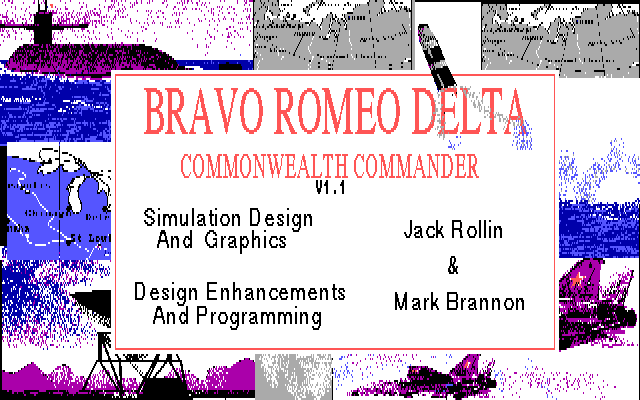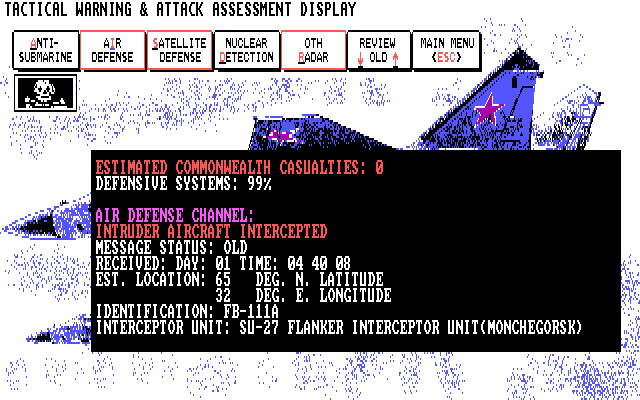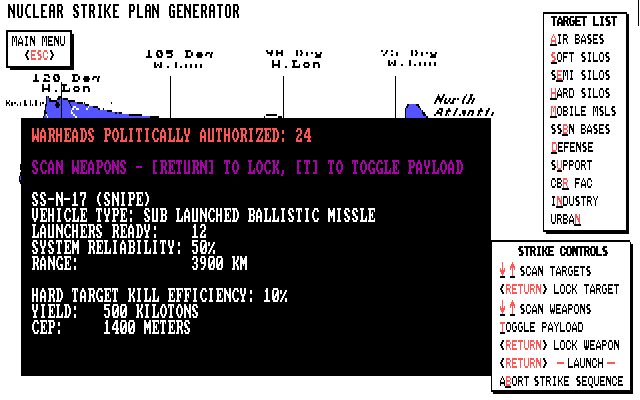Choreographing Armageddon in “Bravo Romeo Delta”
As long as I’m writing about interesting DOS strategy games that have fallen into abandonware, I’ll say a few words for one that appears to more or less have been forgotten by even the Internet: Bravo Romeo Delta.

Bravo Romeo Delta title screen
It’s a simulation of World War III, or at least of one very specific World War III that thankfully never happened: a nuclear war between the United States and the Soviet Union.
(The name comes from a bit of Cold War military lingo; for many years the US’s strategic plan for fighting a nuclear war concentrated on blunting an attack by Soviet ground forces, retarding their ability to reconstitute those forces by building weapons and other military materiel, and disrupting the will of the Soviet people to fight on. In standard military fashion, this list of objectives eventually became an acronym, BRD, which in the phonetic alphabet Western militaries use to avoid communications confusion would be spelled out “Bravo Romeo Delta.”)
The history of Bravo Romeo Delta is difficult to reconstruct today. Very little information is available about it online, save that it was published in the early ’90s, there was also a version of the game for the Commodore Amiga, and that it sold poorly enough that a few years later the developers of the Amiga version were looking to sell the rights and source code for the game to anyone willing to buy them. Whether the Amiga version or the MS-DOS version came first is unclear, as is whether the developers of the Amiga version (Frankenstein Software) also did the MS-DOS version or handed it off to another company to port instead.
It looks like there was at least enough interest in the game to warrant a follow-up/expansion, as the version I have is subtitled “Version 1.1: Commonwealth Commander.” In the original version of the game, you apparently played as the commander of America’s nuclear forces; in version 1.1, you play as his Russian counterpart. (The “Commonwealth” in “Commonwealth Commander” refers to the collective name the various member states of the old Soviet Union settled on for themselves after the USSR collapsed, the Commonwealth of Independent States.)
The objective of a game of Bravo Romeo Delta is pretty simple: you, as the commander of all your nation’s nuclear forces, have to put together a series of nuclear strikes strong enough that it prompts your enemy to surrender, while avoiding making it so strong that it prompts the enemy to drop his entire nuclear arsenal on your head. You are, in other words, fighting what the books call a “limited nuclear war,” not a complete, throw-everything-and-the-kitchen-sink-at-’em Armageddon.
(Interestingly, from what I’ve read of the original version, it sounds like both it and the “Commonwealth Commander” version start with the USSR firing the first nuclear shot. I can’t confirm this since I’ve only played the CC version, but if it’s true, it’s ahistorical; for many decades, NATO doctrine for a war with the Soviets revolved around the idea that the West would be the first side to reach for its nukes, because doing so would be the only way NATO could stop the Soviets’ much larger conventional army and air force from rolling over Western Europe.)

Bravo Romeo Delta: nice knowing ya, DC
Which isn’t to say that Armageddon can’t happen in Bravo Romeo Delta. In fact, it happens quite often. It’s the main way you can lose a game; you miscalculate, throw a little too many warheads at a few too sensitive targets, and the computer player on the other side says “screw it” and hits you with everything it’s got. Then you have no choice but to hit him with everything you’ve got in a desperate bid to flatten his missiles and bombers and submarines before they can hit you; and boom, it’s Armageddon.
If Bravo Romeo Delta really did sell poorly, I can’t say I’m surprised; the interface is extremely spare, even for a game from the MS-DOS era. Practically no concessions have been made to make the game easy to approach or understand. Everything is driven with a few keyboard keys, and hitting the wrong key at the wrong time can result in an order being given that the game gives you no way to rescind. The result is a hardcore nuclear war simulation that would only ever have been of interest to people steeped in the subject matter.
But if you, like me, are one of those people? Then oh, man, this game will fascinate you.
While its interface leaves a lot to be desired, Bravo Romeo Delta doesn’t skimp on realism. The complete range of Cold War nuclear weapons is at your fingertips, from air-dropped bombs to cruise missiles to sub-launched and ground-based ICBMs, with each one modeled to represent accurately its destructive power, range and reliability. And a huge database of potential targets is provided for both sides — not just cities, but bomber and submarine bases, radar stations and interceptor squadrons, industrial facilities and political power centers. This is a game where you don’t say “I’m going to strike their missiles before they can launch them,” you say “I’m going to throw four submarine-launched SS-N-20 missiles at the Malmstrom Air Force Base missile fields in Montana.”
Part of the challenge of the game is just developing a strategy that rides that fine line between too little force and too much. Not that you have much choice, at the opening; when the game starts, you have approval from the political Powers That Be to use only thirty warheads in total. (Only!) But as enemy warheads start to fly, the politicians quickly start raising that figure; it’s the rare game where it takes more than a couple rounds of thermonuclear back-and-forth before the restrictions completely come off. At that point, the only thing holding you back is your strategic calculation of how much force is too much. (And your conscience, if you have one.)
Especially in the beginning, when your resources are limited, selecting targets and finding the right weapons to hit them with is a delicate matter. Not every nuclear weapon in your arsenal is suitable for every target; targets have varying degrees of “hardness”, indicating how much blast force they have been built to withstand, and the harder the target the more clever you have to be to actually destroy it when you hit it. Some targets, like NORAD headquarters at Cheyenne Mountain in Wyoming, are so hardened that only a few of your weapons could possibly take it out. So, if your opening gambit involves hitting NORAD first in a decapitation strike, how many of those 30 warheads do you allocate for that task? Do you launch just one or two bunker-busters and hope for the best while maximizing the number you have available for other targets, or do you plaster the Mountain with five or ten or twenty to try and be certain?

Bravo Romeo Delta: scratch one imperialist bomber, Comrade
Beyond that, however, is another complicating factor: just because you order a particular weapon fired at a particular target, there’s no guarantees that it will actually arrive there. The other side is acting too, and they can neutralize your strikes before they land: bombers can be shot down, missile submarines sunk, missile fields nuked. This puts pressure on you to dedicate at least some of your attacks to so-called “counterforce” targets; a fighter that you destroy on the ground can never shoot down any of your bombers, an attack sub that sinks in Norfolk harbor because you blew up Naval Station Norfolk before the sub could warm up its reactor and get to sea will never sink one of your missile subs, and so forth. But put too much explosive megatonnage into counterforce targets, and you can prompt the Armageddon you’re trying to avoid.
And then there’s the small problem that the enemy is looking at your military resources as potential counterforce targets, too. Most of your subs start off idling in their bases; most of your bombers start off sitting on the ground. All of these “sitting ducks” are just as tempting to the Americans as their sitting ducks are to you. You can limit the amount of damage they can do by pushing up the alert status of particular units — a submarine sitting in port, for instance, can be told to put to sea, where it will be safe from any attack on its base. But warming up a nuclear submarine’s reactor so it can start sailing is a process that can take hours, so your order won’t be carried out right away. And the enemy has satellites that can observe such things as the comings and goings of nuclear submarines; if you suddenly try to “flush” all your submarines out to sea, or order your bombers off the ground and into “airborne alert” status, they may take it as a sign of an imminent major attack and move pre-emptively to hit you with the Armageddon blow before all those sitting ducks can fly away.

Bravo Romeo Delta: “System reliability: 50%”
There’s one final wrinkle to deal with, too: reliability. Like I said above, one of the things the game tracks for each weapon in your arsenal is a failure rate. I don’t know what these look like for American weapons in the original version of the game, but for Soviet weapons, they are depressingly high. The Soviet nuclear force in the game contains a huge variety of different kinds of weapons, but only a few of them offer anything like the kind of reliability you’d generally want from a weapon of mass destruction. Submarine-based missiles, for example can have failure rates on the order of 50-60%, meaning that for every two missiles you order fired, probably only one of them is actually going to make it all the way to the target. Land-based missiles are more reliable, but not infallibly so; they “only” fail about 20-30% of the time. Even the best weapons you have suffer failure rates of 15%. All of which means that you need to throw more warheads at the enemy, to make sure at least some of them will reach their targets; but then the more you throw, the more likely everything becomes to tip over into Armageddon, so…
So yeah: if you’re into making hard strategic decisions, and aren’t put off by having to learn a huge array of acronyms and nuclear weapon names, Bravo Romeo Delta has a lot to offer, even if it is all wrapped up in one of the most impenetrable interfaces I’ve ever encountered. Playing it a few times will give you a new appreciation for how absurd the whole idea of “limited nuclear war” really was — how hard it would have been to stop such a war, once started, from snowballing into the end of the world. Which will make you thankful that nobody ever had to try.
UPDATE (March 12, 2019): In a minor miracle of technology, thanks to the folks at the Internet Archive, you can now play Bravo Romeo Delta in your Web browser.
Don’t say I didn’t warn you.
